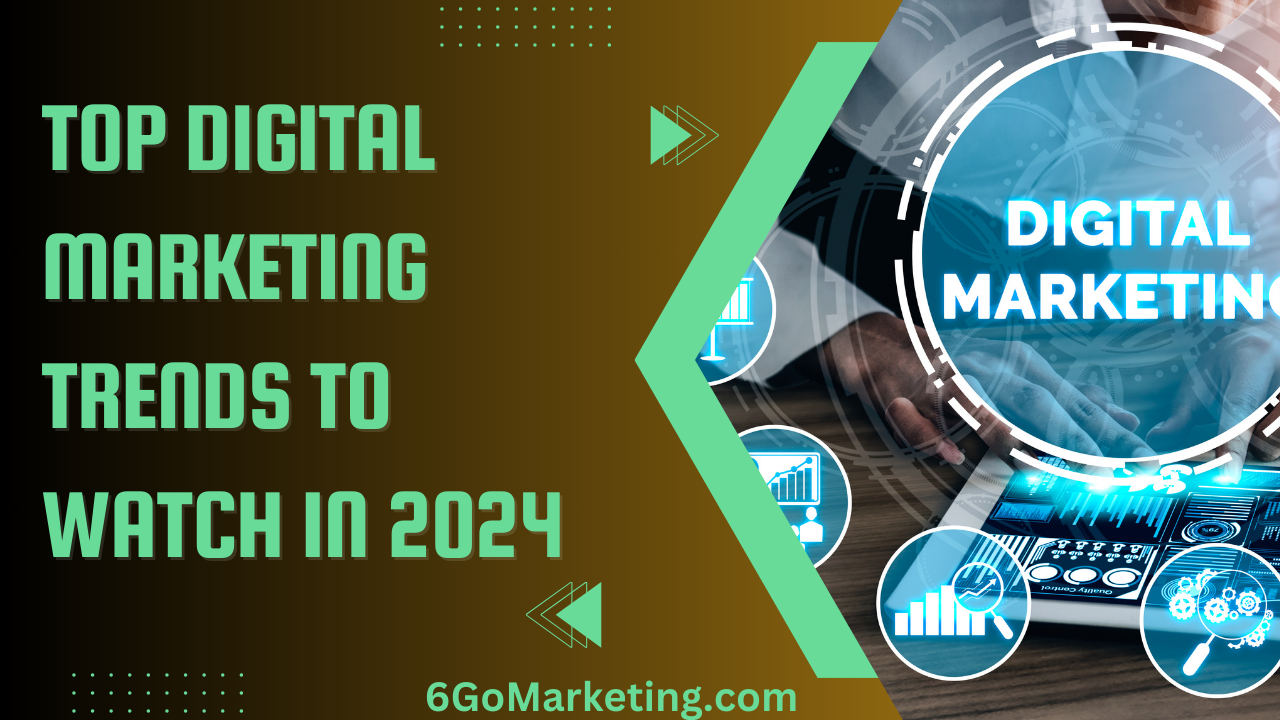Digital marketing continues to evolve at a rapid pace. As we move into 2024, staying on top of the latest trends is essential for marketers looking to stay competitive and meet the changing needs of their audience. With advancements in technology, shifts in consumer behavior, and changes in how businesses operate, understanding the key digital marketing trends can help companies succeed in the digital age.
This post explores the top digital marketing trends to watch in 2024, offering insights into how these trends are shaping the future of marketing. We’ll cover everything from AI-driven marketing to the importance of personalization and the growing role of sustainability in brand messaging.
The Rise of AI-Powered Marketing
Artificial Intelligence (AI) has become a driving force in digital marketing, especially among top IT companies. By 2024, AI-powered marketing tools will be even more sophisticated, allowing businesses to automate complex tasks, provide personalized experiences, and analyze large datasets more efficiently.
Key AI Marketing Applications:
- Chatbots and Virtual Assistants: AI chatbots are becoming more advanced, providing real-time customer support, answering queries, and enhancing user experiences. AI-powered virtual assistants can engage with customers across platforms, improving response times and driving conversions.
- Predictive Analytics: AI allows marketers to predict future trends, consumer behavior, and preferences. With predictive analytics, businesses can tailor their marketing strategies to what customers are likely to do, increasing efficiency.
- AI-Driven Content Creation: AI tools are becoming adept at creating content, from blog posts to social media captions. This allows marketers to scale content production while maintaining quality.
Table: Benefits of AI in Marketing
| AI Benefit | Description |
|---|---|
| Personalization | AI can deliver personalized content based on user behavior. |
| Automation | Automates repetitive tasks like email campaigns and chatbots. |
| Data Analysis | Analyzes large datasets quickly to provide actionable insights. |
| Cost Efficiency | Reduces costs by optimizing marketing processes. |
Personalization at Scale
Personalization is no longer a “nice-to-have” but a necessity in 2024. Consumers expect tailored content, product recommendations, and experiences from brands. The growing availability of data allows businesses to understand their customers’ preferences and deliver content that resonates with them.
Personalized Content Marketing:
Personalized content refers to messaging tailored to specific individuals or segments. Marketers can leverage data to create personalized offers, emails, and ads that increase engagement and conversion rates. Studies show that personalized emails deliver six times higher transaction rates than generic ones.
Dynamic Website Personalization:
Dynamic personalization adjusts website content in real-time based on a visitor’s behavior, location, or past interactions. This technique can improve user experience by showcasing products or services that align with the user’s interests.
Table: Types of Personalization in Digital Marketing
| Type of Personalization | Example |
|---|---|
| Personalized Emails | Sending product recommendations based on previous purchases. |
| Dynamic Website Content | Adjusting homepage banners based on visitor location or history. |
| Customized Ad Campaigns | Targeting users with ads relevant to their search history. |
| Behavioral Targeting | Using browsing behavior to show relevant content or promotions. |
Video Marketing Dominates
Video marketing continues to grow in importance, and by 2024, it is expected to dominate digital platforms. Video content, whether in the form of short clips, live streams, or webinars, can engage audiences more effectively than text or images.
Short-Form Videos:
According to My Comparision Guide, Platforms like TikTok, Instagram Reels, and YouTube Shorts have made short-form videos a must for marketers. These bite-sized pieces of content are highly engaging and shareable, making them perfect for capturing attention in a world of shrinking attention spans.
Live Streaming and Interactive Video:
Live streaming has become a popular way to engage with audiences in real time. From product launches to behind-the-scenes content, live video allows brands to connect with consumers in a more authentic and immediate way. Interactive videos, where users can engage with clickable content, also offer new ways to increase engagement.
Table: Video Marketing Platforms and Their Key Features
| Platform | Key Features |
|---|---|
| YouTube | Long-form video content, live streaming, monetization. |
| TikTok | Short, viral videos, algorithm-based discovery. |
| Instagram Reels | Short-form videos, integration with Instagram stories. |
| Facebook Live | Live streaming, direct interaction with audiences. |
| LinkedIn Video | Professional content, B2B focus, live streaming available. |
Social Commerce Growth
Social commerce—where social media platforms integrate e-commerce functionality—continues to grow in 2024. Social platforms like Instagram, Facebook, and Pinterest now offer businesses the ability to sell products directly through their channels. Consumers increasingly prefer shopping on social media due to its convenience and seamless experience.
In-App Shopping:
In-app shopping allows users to make purchases without leaving the social media platform. This trend is especially popular among younger generations who enjoy the convenience of discovering and purchasing products without navigating to a separate e-commerce site.
User-Generated Content (UGC) for Social Commerce:
UGC, such as customer reviews, testimonials, and social media posts featuring products, can significantly influence purchase decisions. Consumers trust peer recommendations, and incorporating UGC into social commerce can boost credibility and sales.
Table: Social Platforms with E-Commerce Features
| Platform | E-Commerce Feature |
|---|---|
| Shoppable posts, in-app checkout, Instagram shops. | |
| Facebook Shops, in-app purchases, product tags. | |
| Product Pins, buyable pins, Pinterest Shopping Ads. | |
| TikTok | Shoppable videos, direct product links, TikTok Shop. |
The Importance of Sustainability in Marketing
Sustainability is a growing concern for consumers, and brands that prioritize eco-friendly practices are more likely to gain consumer trust in 2024. More customers are making purchasing decisions based on a company’s environmental impact, and businesses are responding by integrating sustainability into their marketing strategies.
Green Marketing:
Green marketing focuses on promoting environmentally friendly products, services, or practices. Companies that use sustainable packaging, reduce carbon emissions, or donate to environmental causes can highlight these efforts in their marketing campaigns to appeal to eco-conscious consumers.
Sustainability as a Brand Value:
Brands are increasingly making sustainability part of their core values. For example, Patagonia has long been known for its environmental activism, and this commitment to sustainability has resonated with its audience, contributing to brand loyalty.
Table: Key Sustainability Marketing Strategies
| Sustainability Strategy | Example |
|---|---|
| Eco-Friendly Packaging | Using recyclable or biodegradable materials for product packaging. |
| Carbon Offset Programs | Offsetting carbon emissions from product manufacturing or shipping. |
| Corporate Social Responsibility | Partnering with environmental organizations or supporting green causes. |
| Transparency in Sourcing | Being open about where and how products are sourced. |
Privacy and Data Security
As data privacy becomes a growing concern among consumers, digital marketers must prioritize transparency and secure customer data. Regulations like GDPR (General Data Protection Regulation) and CCPA (California Consumer Privacy Act) require businesses to be clear about how they collect, use, and store data.
Data Transparency:
In 2024, brands need to communicate clearly about their data practices. Companies must ensure that their customers know what data is being collected and how it will be used. Transparent data policies help build trust with consumers, which is essential for long-term loyalty.
The Role of First-Party Data:
With the phasing out of third-party cookies, first-party data—information collected directly from customers—has become more critical. Marketers need to focus on building and leveraging first-party data through tactics like email sign-ups, loyalty programs, and direct customer interactions.
Table: Ways to Collect First-Party Data
| First-Party Data Collection Method | Description |
|---|---|
| Email Sign-Ups | Encouraging visitors to subscribe to newsletters or offers. |
| Loyalty Programs | Offering rewards or incentives for customer information. |
| Interactive Quizzes/Surveys | Using quizzes or surveys to collect data directly from users. |
| Purchase History | Analyzing past purchase data to tailor future recommendations. |
Influencer Marketing Continues to Evolve
Influencer marketing has been a powerful strategy for years, but in 2024, it continues to evolve. Micro-influencers (those with smaller but highly engaged audiences) are becoming increasingly valuable for brands looking to reach niche markets. At the same time, authenticity remains key—consumers can quickly spot inauthentic endorsements, so brands must work with influencers whose values align with their own.
Rise of Micro-Influencers:
Micro-influencers are more affordable for smaller businesses and often have stronger relationships with their audiences compared to major celebrities. Their followers are more likely to trust their recommendations, leading to higher engagement and conversion rates.
Long-Term Partnerships:
Brands are moving away from one-off influencer campaigns and focusing on long-term partnerships. Building a long-term relationship with influencers creates more consistent messaging and fosters deeper trust between the brand, the influencer, and the audience.
Voice Search and Conversational AI
Voice search is growing rapidly, driven by the increasing use of smart speakers and voice-activated virtual assistants like Alexa, Google Assistant, and Siri. By 2024, it is estimated that voice search will account for 50% of all searches, and businesses need to optimize their content for voice-based queries.
Optimizing for Voice Search:
Voice search queries are typically longer and more conversational than text-based searches. Marketers need to focus on optimizing content for natural language, using long-tail keywords, and providing direct answers to common questions.
Conversational AI
Conversational AI, powered by natural language processing (NLP) and machine learning, is transforming how businesses interact with customers. From chatbots to virtual assistants, conversational AI enables personalized, real-time communication that enhances user experience and drives engagement.
By 2024, conversational AI is expected to become even more sophisticated, allowing businesses to handle more complex customer queries and provide tailored responses. This trend is particularly important for customer service and e-commerce, where AI-powered chatbots can assist customers with product recommendations, order tracking, and problem-solving.
Benefits of Conversational AI:
- 24/7 Availability: Chatbots can provide instant responses to customer queries at any time, improving customer satisfaction.
- Scalability: Businesses can manage large volumes of customer interactions without the need for additional human resources.
- Personalization: Conversational AI can analyze user data to provide personalized recommendations and responses, making the interaction more relevant.
- Cost-Efficiency: By automating routine customer service tasks, businesses can reduce operational costs while maintaining high levels of customer support.
Table: Advantages of Conversational AI in Digital Marketing
| Advantage | Description |
|---|---|
| 24/7 Customer Support | Provides continuous support without human intervention. |
| Improved User Experience | Delivers faster and more personalized responses to queries. |
| Higher Engagement Rates | Engages customers with relevant information in real time. |
| Increased Conversions | Assists users with product recommendations, driving purchases. |
The Growth of Omnichannel Marketing
In 2024, omnichannel marketing is no longer optional—it’s a necessity for brands that want to meet consumers where they are. Consumers interact with brands across multiple touchpoints, including websites, social media, mobile apps, email, and physical stores. An effective omnichannel strategy ensures a seamless, consistent experience across all these platforms.
Benefits of Omnichannel Marketing:
- Unified Customer Experience: Omnichannel marketing creates a cohesive customer journey, allowing users to move between devices and platforms without interruption. For example, a customer might begin browsing products on a mobile app and complete the purchase on a desktop, with all their information saved.
- Improved Data Collection: Marketers can collect data from various channels to build a complete picture of customer behavior. This helps create more targeted campaigns and improve customer segmentation.
- Increased Customer Retention: Offering consistent experiences across channels enhances customer satisfaction and loyalty, leading to higher retention rates.
Table: Key Elements of an Omnichannel Marketing Strategy
| Element | Description |
|---|---|
| Consistent Messaging | Ensures that brand messaging remains uniform across all platforms. |
| Cross-Channel Integration | Allows users to switch between channels without losing progress. |
| Personalized Experiences | Tailors content and offers to individual customers based on data. |
| Real-Time Engagement | Engages customers instantly across multiple platforms. |
Data-Driven Marketing and Analytics
Data is the backbone of successful digital marketing strategies, and 2024 will see an even greater emphasis on data-driven decision-making. With access to a wealth of customer information, businesses can craft more effective marketing campaigns, track performance, and make informed decisions based on real-time data.
Leveraging this data, top digital strategy agencies are helping brands create personalized experiences and optimize campaigns, ensuring they stay ahead in an increasingly competitive market.
The Role of Predictive Analytics:
Predictive analytics uses historical data, machine learning, and AI to forecast future outcomes, allowing marketers to anticipate customer behavior and optimize their campaigns. For example, predictive analytics can help identify which products a customer is likely to buy, allowing businesses to offer more personalized product recommendations.
Attribution Models:
Understanding the customer journey and how different touchpoints contribute to a sale is crucial for optimizing marketing strategies. Attribution models—such as first-click, last-click, and multi-touch—help marketers allocate resources to the most effective channels and campaigns.
Table: Common Attribution Models in Digital Marketing
| Attribution Model | Description |
|---|---|
| First-Click | Attributes all credit to the first interaction with the brand. |
| Last-Click | Attributes all credit to the final interaction before conversion. |
| Multi-Touch | Distributes credit across all touchpoints in the customer journey. |
| Time Decay | Gives more credit to touchpoints closer to the conversion event. |
Sustainability and Social Responsibility
As consumers become more conscious of environmental and social issues, businesses must align their values with these concerns. By 2024, sustainability and corporate social responsibility (CSR) will play an even greater role in digital marketing strategies. Consumers, especially younger generations, prefer brands that demonstrate ethical practices and contribute positively to society.
The Rise of Green Marketing:
Green marketing focuses on promoting products or services based on their environmental benefits. This includes highlighting eco-friendly packaging, sustainable sourcing, and ethical labor practices. Consumers are increasingly willing to pay a premium for sustainable products, making green marketing an essential strategy for businesses looking to appeal to eco-conscious customers.
Social Responsibility in Brand Messaging:
Consumers are drawn to brands that stand for more than just profits. In 2024, brands that support social causes, promote diversity, and give back to communities will gain favor with consumers. Authenticity is key—brands must ensure that their social responsibility efforts are genuine and not simply a marketing ploy.
Table: Examples of Sustainability and Social Responsibility in Marketing
| Strategy | Example |
|---|---|
| Eco-Friendly Products | Marketing products made from sustainable or recycled materials. |
| Charitable Partnerships | Partnering with non-profit organizations to support social causes. |
| Transparency in Supply Chain | Sharing details about where products are sourced and manufactured. |
| Carbon Footprint Reduction | Highlighting efforts to reduce carbon emissions in operations. |
The Importance of Customer Experience (CX)
Customer experience (CX) is at the heart of every successful digital marketing strategy in 2024. As competition increases, brands must focus on delivering exceptional experiences that keep customers coming back. CX encompasses every interaction a customer has with a brand, from initial contact to post-purchase support.
CX and Personalization:
Personalization is a critical aspect of a positive customer experience. In 2024, consumers expect brands to understand their needs and preferences, offering personalized recommendations, content, and support. Companies that fail to deliver personalized experiences risk losing customers to competitors who can.
Omnichannel CX:
A seamless omnichannel experience is essential for delivering high-quality customer service. Brands must ensure that customers can engage with them across various platforms, whether through social media, email, or in-store, without friction.
Table: Key Metrics for Measuring Customer Experience
| CX Metric | Description |
|---|---|
| Net Promoter Score (NPS) | Measures customer loyalty by asking how likely they are to recommend the brand. |
| Customer Satisfaction | Gauges overall customer satisfaction with a product or service. |
| Customer Effort Score | Measures how easy it is for customers to interact with the brand. |
| Churn Rate | Tracks the percentage of customers who stop using the service or product. |
Conclusion
2024 is shaping up to be an exciting year for digital marketing, with new technologies, changing consumer expectations, and a growing emphasis on sustainability and personalization. AI-powered marketing, omnichannel strategies, and data-driven decisions are transforming how brands engage with their audiences. By staying on top of these trends, businesses can create more effective, customer-centric marketing strategies that drive results.
The digital marketing landscape is evolving, and the brands that succeed in 2024 will be those that embrace innovation, prioritize the customer experience, and align their values with those of their consumers. By leveraging the trends discussed in this post, businesses can stay ahead of the competition and thrive in the ever-changing digital world.









